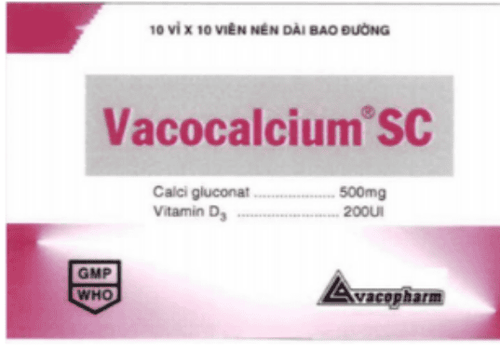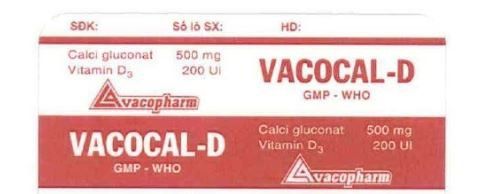This is an automatically translated article.
The drug Calcijex has the main ingredient Calcitriol, the drug is prepared in the form of an isotonic, clear, colorless to pale yellow solution for intravenous injection. Please refer to the article below for more useful information about this drug.1. What is Calcijex?
Calcijex with the main ingredient Calcitriol, is formulated as a 1 mL tube, each 1 mL contains Calcitriol 1mcg, Polysorbate 20.4 mg, Sodium ascorbate 2.5 mg and Hydrochloric Acid and/or Sodium hydroxide for pH adjustment. The pH of the drug is 6.5 (5.9 - 7.0).
Calcitriol is the active form of vitamin D3 - Cholecalciferol. The supply of vitamin D in humans is mainly dependent on ultraviolet light for the conversion of 7-dehydrocholesterol to vitamin D3 in the skin. Vitamin D3 is activated in the liver and kidneys before being used in target tissues. The initial conversion is catalyzed by the liver enzyme that produces Calcifediol. It then undergoes hydroxylation in the mitochondria of kidney tissue to produce Calcitriol - the active form of vitamin D3.
Calcitriol's sites of action are the intestines, bones, kidneys and parathyroid glands:
Calcitriol helps stimulate intestinal calcium transport. In bone, Calcitriol combines with parathyroid hormone, stimulates calcium reabsorption; In the kidney, calcitriol increases tubular calcium reabsorption; Calcitriol directly inhibits the secretion and synthesis of PTH; Vitamin D resistance may persist in patients with uremia because the kidneys are unable to adequately convert the precursors to Calcitriol. Then Calcitriol will be added from the outside.
2. Indications of the drug Calcijex
Calcijex is indicated for use in the management of hypocalcemia in patients undergoing chronic renal dialysis. The drug has been shown to significantly reduce elevated parathyroid hormone levels. Reducing PTH improves renal osteodystrophy.
On the other hand, the drug is not allowed to be prescribed in the following cases:
Calcijex should not be used in patients with hypercalcemia or there is evidence of vitamin D toxicity. Calcijex is contraindicated in patients with known hypersensitivity to the drug. calcitriol or any of the excipients of Calcijex.
3. Be careful when using Calcijex
Calcitriol is the most potent metabolite of vitamin D available, so it is advisable to use the kidneys during treatment to avoid the risk of hypercalcaemia. A compound that is not bound to aluminum phosphate should be used to control serum phosphorus levels in patients on dialysis. Taking an overdose of any form of vitamin D is very dangerous. Progressive hypercalcemia due to overdose of vitamin D and its metabolites can be so severe that it requires emergency medical care. Chronic hypercalcemia can lead to systemic vascular calcifications, renal calcifications, and other soft tissue calcifications. Non-radiographic evaluation of suspicious anatomical areas will be helpful in the early detection of this condition; Overdosage of the drug Calcijex causes hypercalcemia and in some cases also causes hypercalciuria; Therefore, when treatment requires dosage adjustment, serum calcium and phosphorus should be determined at least 2 times per week. If hypercalcaemia develops, Calcijex should be discontinued immediately; Calcijex should be used with caution in patients receiving digitalis therapy, as hypercalcemia in these patients may lead to cardiac arrhythmias; Patients should be informed about following dietary and supplemental calcium guidelines and avoiding over-the-counter medications, including magnesium-containing antacids.
4. Drug interactions of the drug Calcijex
The use of Calcijex and magnesium-containing products should be used with caution because concomitant use may lead to hypermagnesaemia; Corticosteroids with glucocorticoid activity may counteract the bone and mineral metabolism effects of vitamin D derivatives; Anticonvulsants that affect cytochrome P450 enzymes such as carbamazepine, phenobarbital, and phenytoin may reduce the effects of vitamin D because they increase vitamin D catabolism.
5. Using Calcijex in special subjects
Calcitriol was found to be teratogenic in rabbits when administered orally at doses of 0.08 and 0.3 mcg/kg. However, there are no adequate and well-controlled studies with the use of Calcijex in pregnant women. Calcijex should be used during pregnancy only if the potential benefit outweighs the potential risk to the fetus.
It is not known whether Calcijex is excreted in human milk. Although many drugs containing Calcitriol are excreted in human milk and have the potential to cause serious adverse reactions in nursing infants, the decision to discontinue nursing or to discontinue the drug depends on the importance of the drug to the patient. mom.
The dose selection of Calcijex for elderly patients should be cautious, usually starting at the lowest end of the dose range, taking into account the frequency of decreased liver, renal, cardiac function, comorbidities, and medications to which the patient is concerned. using.
6. Calcijex side effects
In general, the adverse effects of Calcijex are similar to those experienced with excessive vitamin D intake. Early and late signs and symptoms of hypercalcemia-related vitamin D toxicity include:
Early symptoms: Asthenia, headache, drowsiness, nausea, vomiting, dry mouth, constipation, muscle pain, bone pain, metallic taste, loss of appetite, abdominal pain and epigastric discomfort. Late symptoms: polyuria, polyuria, anorexia, weight loss, nocturia, conjunctivitis (calcification), pancreatitis, photophobia, epistaxis, pruritus, hyperthermia, decreased libido, increased BUN, albuminuria, hypercholesterolemia, increased SGOT and SGPT, ectopic calcification, hypertension, arrhythmia, kidney failure, sensory disturbances, dehydration, lethargy, rarely psychosis mild pain when injecting.
7. Dosage and how to use Calcijex
Calcijex is for intravenous use only. The optimal dose of Calcijex must be carefully determined for the individual patient.
The recommended starting dose of Calcijex, depending on the severity of hypocalcemia and/or secondary hyperparathyroidism, is usually 1 mcg (0.02 mcg/kg) to 2 mcg IV. 3 times per week, injected every other day. In clinical practice, a dose range of 0.5 mcg - 4 mcg administered 3 times per week is commonly used as the initial dose. If the expected response is not observed, the dose may be increased by 0.5 - 1 mcg at intervals of 2 to 4 weeks.
During this dose adjustment period, serum calcium and phosphorus levels should be monitored at least twice weekly. If hypercalcaemia is noted, the drug should be discontinued immediately.
In summary, Calcijex dosing should be individualized and commensurate with PTH, serum calcium and phosphorus levels.
Please dial HOTLINE for more information or register for an appointment HERE. Download MyVinmec app to make appointments faster and to manage your bookings easily.













